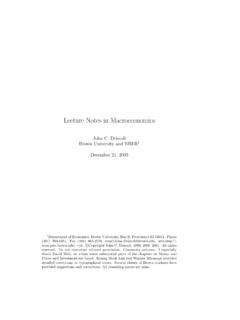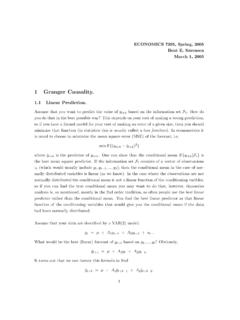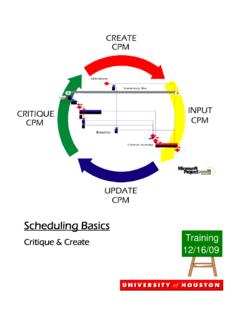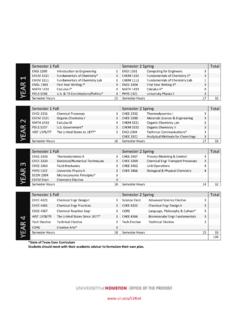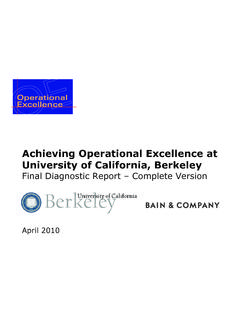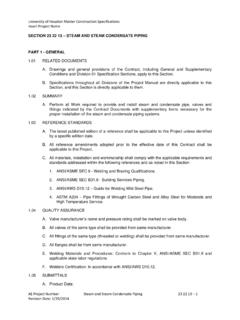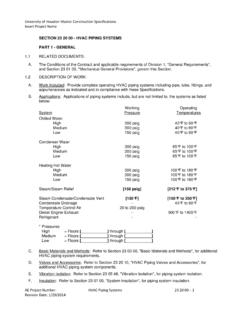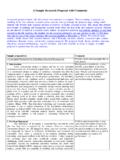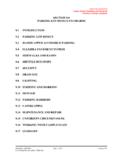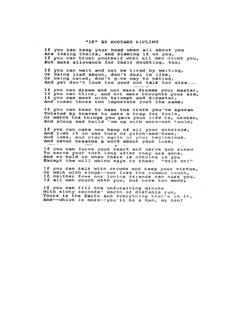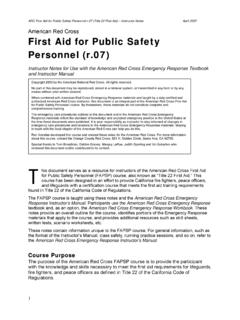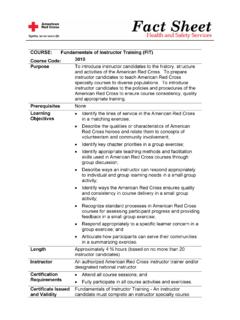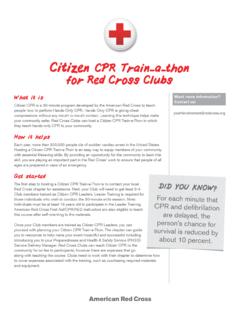Transcription of Program: First Aid/CPR/AED - University of Houston
1 Program: First Aid/CPR/AED . Purpose The purpose of the american Red cross First Aid/CPR/AED program is to help participants recognize and respond appropriately to cardiac, breathing and First aid emergencies. The courses in this program teach skills that participants need to know to give immediate care to a suddenly injured or ill person until more advanced medical personnel arrive and take over. This program offers a choice of First aid, CPR and AED courses to meet the various training needs of a diverse audience. Prerequisites None. Learning Objectives Before Giving Care and Checking an Injured or Ill Person Describe how to recognize an emergency.
2 Explain when to move an injured or ill person Describe how to prioritize care for injuries and from a dangerous scene. sudden illnesses. Explain how to check a conscious person for Describe the purpose of Good Samaritan laws. life-threatening and non-life-threatening Identify the difference between (expressed) conditions. consent and implied consent. Identify the signals of shock. Identify how to reduce the risk of disease Describe how to minimize the effects of shock. transmission when giving care. Demonstrate how to check an unconscious Explain how to activate and work with the person for life-threatening conditions. emergency medical services (EMS) system.
3 CPR/AED. Recognize the signals of a cardiac emergency. Demonstrate how to care for a person who is Identify the links in the Cardiac Chain of choking. Survival. Explain what defibrillation is. Describe how to care for a heart attack. Explain how defibrillation works. List the causes of cardiac arrest. Identify precautions to take when using an AED. Explain the role of CPR in cardiac arrest. on a person in sudden cardiac arrest. Demonstrate how to perform CPR. Demonstrate how to use an AED. Recognize the signals of a breathing emergency. First Aid Identify the signals of common sudden Identify the signals of heat-related illnesses and illnesses.
4 Cold-related emergencies. Describe how to care for common sudden Describe how to care for heat-related illnesses illnesses. and cold-related emergencies. Describe how to care for someone who is Explain how to care for head, neck and spinal having a seizure. injuries Identify signals of various soft tissue and Demonstrate how to control external bleeding. musculoskeletal injuries. Identify signals of head, neck and spinal injuries. Describe how to care for various soft tissue and musculoskeletal injuries. Explain how to care for muscle, bone or joint injuries. Optional Demonstrate how to splint a muscle, bone or Describe the appropriate assessment and joint injury.
5 Documentation of the person's response to an Identify the signals of asthma. epinephrine auto-injection. Describe the care given to a person Describe how to report the event of an allergic experiencing an asthma attack. reaction and your care given to EMS personnel. Describe how to report the event of an asthma Demonstrate the use of an epinephrine auto- attack and your care to emergency medical injector. services (EMS) personnel. Demonstrate appropriate handling, use and Demonstrate the use of a meter-dosed inhaler. disposal of an epinephrine auto-injector. Identify the signals of anaphylaxis. Demonstrate how to control severe, Describe the care given to a person uncontrollable external bleeding using a experiencing anaphylaxis.
6 Manufactured tourniquet. Length Course lengths vary depending on the course components included, ranging from about 2 hours to just over 5. hours. Instructor Currently certified First Aid/CPR/AED , Lifeguarding and Emergency Medical Response instructors and instructor trainers. Certification Requirement Attend all class sessions. Participate in all course activities. Demonstrate competency in all required skills. Successfully participate in an end-of-course scenario(s). Certificate Issued and Validity Period CPR Adult: 2 years CPR Child: 2 years CPR Infant: 2 years CPR/AED Adult: 2 years CPRAED Child: 2 years Standard First Aid: 2 years Pediatric First Aid: 2 years Participant Products/Materials (available in e-book and print formats).
7 american Red cross First Aid/CPR/AED Participant's Manual american Red cross Adult First Aid/CPR/AED Ready Reference Card american Red cross Pediatric First Aid/CPR/AED Ready Reference Car
